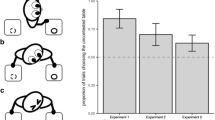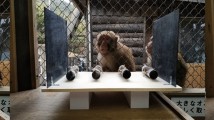Abstract
In a previous study, Kuroshima and colleagues demonstrated that capuchin monkeys (Cebus apella) learned to discriminate between a “knower” who inspected a box for food, and a “guesser” who did not. The aim of the present study was to specify whether the subjects learned a simple conditional discrimination or a causal relationship that seeing leads to knowing. In experiment 1, we introduced five types of novel containers to two subjects. Each container was of different shape and color. The subjects gradually learned to reach toward the container the knower suggested. In experiment 2, we diversified the behavior of the knower and the guesser. In experiment 3, in order to eliminate the possibility of discrimination based on differences in the magnitude and the complexity of two trainers, we equated their behaviors. One subject adapted to the novel behaviors of the knower and the guesser, successfully discriminating the two trainers. Thus this monkey clearly learned to use the inspecting action of the knower and the non-inspecting action of the guesser as a discriminative cue to recognize the baited container. This result suggests that one capuchin monkey learned to recognize the relationship between seeing and knowing.






Similar content being viewed by others
References
Boinski S, Quatrone RP, Swartz H (2000) Substrate and tool use by brown capuchins in Suriname: ecological contexts and cognitive bases. Am Anthropol 102:741–761
Byrne RW, Whiten A (1988) Machiavellian intelligence: social expertise and the evolution of intellect in monkeys, apes, and humans. Oxford University Press, New York
Call J, Tomasello M (1998) Distinguishing intentional from accidental actions in orangutans (Pongo pygmaeus), chimpanzees (Pan troglodytes), and human children (Homo sapiens). J Comp Psychol 112:192–206
Coussi-Korbel S, Fragaszy DM (1995) On the relation between social dynamics and social learning. Anim Behav 50:1441–1453
Fujita K, Kuroshima H, Masuda T (2001) Do tufted capuchin monkeys (Cebus apella) spontaneously deceive opponents? A preliminary analysis of an experimental food-competition contest between monkeys. Anim Cogn 5:19-25
Fujita K, Kuroshima H, Asai S (2003) How do tufted capuchin monkeys (Cebus apella) understand causality involved in tool use? J Exp Psychol Anim Behav Process 29:233–242
Hare B, Call J, Agnetta B, Tomasell M (2000) Chimpanzees know what conspecifics do and do not see. Anim Behav 59:771–785
Hattori Y, Kuroshima H, Fujita K (2002) Understanding of the other’s intention in cooperation task in capuchin monkeys. The 62nd Japanese Society for Animal Psychology Conference at Doshisha University, August 5–6
Heyes C (1994) Cues, convergence and a curmudgeon: a reply to Povinelli. Anim Behav 48:242–244
Heyes C (1998) Theory of mind in nonhuman primates. Behav Brain Sci 21:101–148
Hirata S, Matsuzawa T (2001) Tactics to obtain a hidden food item in chimpanzee pairs (Pan troglodytes). Anim Cogn 4:285–295
Izawa K, Mizuno A (1977) Palm-fruit cracking behavior of wild black-capped capuchin (Cebus apella). Primates 18:773–792
Kuroshima H, Fujita K, Fuyuki A, Masuda T (2002) Understanding of the relationship between seeing and knowing by tufted capuchin monkeys (Cebus apella). Anim Cogn 5:41–48
Menzel EW (1974) A group of chimpanzees in a 1-acre field: leadership and communication. In: Schrier AM, Stollnitz F (eds) Behavior of nonhuman primates. Academic, New York, pp 83–153
Povinelli DJ, de Blois S (1992) Young children’s (Homo sapiens) understanding of knowledge formation in themselves and others. J Comp Psychol 106:228–238
Povinelli DJ, Nelson KE, Boysen ST (1990) Inferences about guessing and knowing by chimpanzees (Pan troglodytes). J Comp Psychol 104:203–210
Povinelli DJ, Parks KA, Novak MA (1991) Do rhesus monkeys (Macaca mulatta) attribute knowledge and ignorance to other? J Comp Psychol 105:318–325
Povinelli DJ, Perilloux HK, Reaux JE, Bierschwale DT (1998) Young and juvenile chimpanzees’ (Pan troglodytes) reactions to intentional versus accidental and inadvertent actions. Behav Process 42:205–218
Pratt C, Bryant P (1990) Young children understand that looking leads to knowing (so long as they are looking into a single barrel). Child Dev 61:973–982
Premack D (1988) ‘Does the chimpanzee have a theory of mind?’ revisited. In: Byrne R, Whiten A (eds) Machiavellian intelligence: social expertise and the evolution of intellect in monkeys, ape, and humans. Clarendon, Oxford, pp 160–179
Vick SJ, Anderson JR (2000) Learning and limits of use of eye gaze by capuchin monkeys (Cebus apella) in an object-choice task. J Comp Psychol 114, 200–207
Visalberghi E, Limongelli L (1994) Lack of comprehension of cause effect relations in tool using capuchin monkeys (Cebus apella). J Comp Psychol 108:15–22
Visalberghi E, Fragszy DM, Savage-Rumbaugh S (1995) Performance in a tool-using task by common chimpanzees (Pan troglodytes), bonobos (Pan paniscus), an orangutan (Pongo pygmaeus), and capuchin monkeys (Cebus apella). J Comp Psychol 109:52–60
Visalberghi E, Quarantotti BP, Tranchida F (2000) Solving a cooperation task without taking into account the partner’s behavior: the case of capuchin monkeys (Cebus apella). J Comp Psychol 114:297–301
Waal FB de (1997) Food transfers through mesh in brown capuchins. J Comp Psychol 111:370–378
Want SC, Harris PL (2001) Learning from other people’s mistakes: causal understanding in learning to use a tool. Child Deve 72:431–443
Westergaard GC (1999) Structural analysis of tool-use by tufted capuchins (Cebus apella) and chimpanzees (Pan troglodytes). Anim Cogn 2:141–145
Westergaard GC, Liv C, Chavanne T, Suomi SJ (1998) Token-mediated tool-use by a tufted capuchin monkey (Cebus apella). Anim Cogn 1:101–106
Whiten A, Byrne RW (1988) The manipulation of attention in primate tactical deception. In: Byrne RW, Whiten A (eds) Machiavellian intelligence: social expertise and the evolution of intellect in monkeys, apes, and humans. Clarendon, Oxford, pp 1–9
Acknowledgements
This study was supported by Research Fellowships of the Japan Society of the Promotion of Science for Young Scientists to the first author, and by a Grant-in-Aid for Scientific Research from the Ministry of Education, Science, Sports, and Culture (Nos. 10610072, and 13410026) to the second author. It was also supported by the Cooperative Research Program from the Primate Research Institute, Kyoto University. We thank Satoru Ishikawa, Shunji Awazu, and Hiroko Kuwahata for useful comments in conducting experiments. Thanks are also due to James R. Anderson for his editing of and many comments on the manuscript. The experiments complied with the Guide for the care and use of laboratory primates, Primate Research Institute, Kyoto University.
Author information
Authors and Affiliations
Corresponding author
Rights and permissions
About this article
Cite this article
Kuroshima, H., Fujita, K., Adachi, I. et al. A Capuchin monkey (Cebus apella) recognizes when people do and do not know the location of food. Anim Cogn 6, 283–291 (2003). https://doi.org/10.1007/s10071-003-0184-9
Received:
Revised:
Accepted:
Published:
Issue Date:
DOI: https://doi.org/10.1007/s10071-003-0184-9




